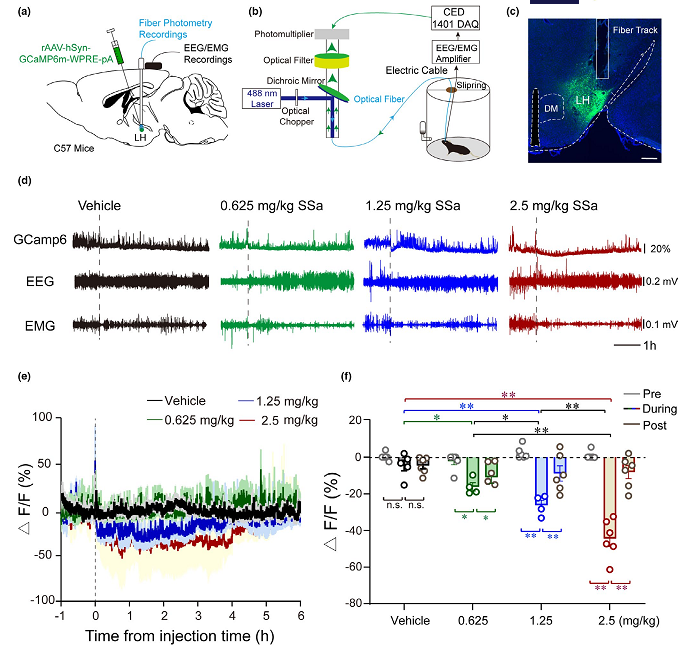AAV-GCaMp6m was used for fibre photometry experiment. (From
BrainVTA)
The viruses used in this article from BrainVTA are in the table below
|
Control |
PT-0148 rAAV-hSyn-GCaMp6m-WPRE-hGH polyA |
Yu-Heng Zhong, Shan Jiang, Wei-Min Qu, Wen Zhang, Zhi-Li Huang, Chang-Rui Chen
Pub Date: 2021-09-12,
DOI: 10.1111/jsr.13484,
Email: sales@brainvta.com
Insomnia is one of the most prevalent sleep disorders, which imparts tremendous societal and economic impact. However, the present pharmacotherapy is greatly limited by adverse effects, so it is necessary to explore new drugs for the treatment of insomnia. Radix Bupleuri (RB) has been widely used in traditional Chinese medicine for >2000 years; it has many pharmacological effects, including sedation and anticonvulsant properties. The present study investigated the effects of saikosaponin a (SSa), an active component of RB, on sleep and locomotion. Male C57BL/6j mice received intraperitoneal injections of SSa at three different dosages (0.625, 1.25, and 2.5 mg/kg). Sleep parameters were analysed by electroencephalography and electromyography. The open-field test was used to measure locomotor activities. Our present results showed that SSa treatment significantly increased the duration of non-rapid eye movement sleep and shortened sleep latency in a dose-dependent manner. A high dose of SSa (2.5 mg/kg) also decreased locomotor activities. Moreover, by measuring c-Fos expression and the calcium signal in the lateral hypothalamus (LH), we found that SSa treatment decreased neuronal activity in the LH. In conclusion, SSa might be the sleep-promoting component in RB and its mechanism may be related to the modulation of neuronal activity in the LH.
 Figure 1. Saikosaponin a(SSa) decreased neuronal activities in the lateral hypothalamus (LH).
Figure 1. Saikosaponin a(SSa) decreased neuronal activities in the lateral hypothalamus (LH).
In the study, using electroencephalography/electromyography (EEG/EMG) recording, the open- field test (OFT), immuno-histochemistry, and in vivo fibre photometry, the authors revealed that the non-rapid eye movement (NREM) sleep-promoting and sedative effects of SSa were modulated by inhibiting neuronal activities in the LH. Overall, their present findings uncovered a vital constituent of RB in promoting sleep, supporting the potential uses of SSa as a medicinal agent for insomnia.
BrainVTA offers viral vector construction & virus packaging services for AAV, LV, RABV, PRV, HSV and VSV that help researchers explore questions about genes, neurons, circuitry structure, function of brain network, mechanism and treatment of diseases.
If you have any needs, just email us at
sales@brainvta.com.
